Abstract
Under mixed sparse line-of-sight/non-line-of-sight (LOS/NLOS) conditions, how to quickly achieve high positioning accuracy is still a challenging task and a critical problem in the last dozen years. To settle this problem, we propose a constrained L1 norm minimization method which can reduce the effects of NLOS bias for improve positioning accuracy and speed up calculation via an iterative method. We can transform the TOA-based positioning problem into a sparse optimization one under mixed sparse LOS/NLOS conditions if we consider NLOS bias as outliers. Thus, a relatively good method to deal with sparse localization problem is L1 norm. Compared with some existing methods, the proposed method not only has the advantages of simple and intuitive principle, but also can neglect NLOS status and corresponding NLOS errors. Experimental results show that our algorithm performs well in terms of computational time and positioning accuracy.
1. Introduction
In the last few decades, localization of the mobile station (MS) is a fundamental task for lots of applications in different kinds of wireless sensor networks. One of them uses MS to receive time signals from a lot of base stations (BSs) with known coordinates, which can be transformed into distance data, e.g., time-of-arrival (TOA) measurements [1,2,3,4,5,6]. According to these measurements, the coordinates of MS can be estimated in the intersection area of different circles, whose centers and radius are the coordinates of BSs and corresponding measurements, respectively. If the intersection area becomes larger, the coordinates of MS will be difficult to be estimated and the corresponding positioning performance will be degraded. Additionally, note that Gaussian noise, NLOS error and layout of BSs are the most important factors that affect the size of the intersection area [7,8,9,10,11,12,13,14,15,16,17,18,19,20,21,22,23,24,25]. Among them, NLOS error may be the most influential factor because it can directly lead to inaccurate measurements, resulting in inaccurate localization results or even divergence [7,8,9,10,11,12,13,14,15,16,17,18,19,20,21,22,23,24,25,26,27,28,29,30,31]. Therefore, it is of great practical significance to study how to improve the positioning performance and degrade the effects of NLOS errors without requiring the priori information of NLOS status and NLOS errors. In this paper, we deal with the TOA-based localization problem by constrained L1-norm minimization technique.
To reduce the effects of NLOS errors and enhance the positioning performance, lots of methods have been widely studied in [7,8,9,10,11,12,13,14,15,16,17,18,19,20,21,22,23,24,25,26,27,28,29,30,31]. In [10], a fast identification of NLOS error using eigenvector (FINE) algorithm is proposed by using autocorrelation matrix eigenvalues of residuals to identify the NLOS paths. According to the magnitude of residuals and eigenvalues, only one NLOS path can be identified at a time. Then, corresponding BS and observation should be deleted so as to detect the next NLOS path. Only when there is no NLOS path can the positioning result be obtained with all the LOS observations. Monte Carlo simulation results show that FINE method can provide a very fast and simple way to identify the NLOS status. Nevertheless, it can also detect LOS path as NLOS path and neglect the contribution of NLOS paths, which ultimately degrades the positioning accuracy.
Furthermore, some convex optimization algorithms in [9], and in [15,16,17,18,19,20,21,22], which partially mitigate the effects of NLOS errors by using all LOS and NLOS measurements, perform well in terms of localization performance. In [9], the semi-definite relaxation (SDR) and second-order cone relaxation (SOCR) technologies are taken by using all measurements. Although they have the ability to overcome some effects of NLOS errors and achieve good results, there is still a lot of room for improvement in terms of positioning accuracy. Fortunately, based on a priori knowledge of known NLOS status, Wang et al. [9] presents another two algorithms, both of which achieve exceedingly high positioning accuracy over former methods by adding all equality constraints in LOS paths and inequality constraints in NLOS paths to convex objective function. However, two algorithms are only suitable for theoretical research and cannot be extended to the industrial market because their assumptions cannot be realized in reality. Recently, a new robust SDP algorithm (RSDP-New) is presented in [16], which performs well under mixed LOS/NLOS environments and achieves high-precision positioning by introducing a balance parameter and specifying the values of NLOS errors in advance. However, its disadvantages, which are that the constraints are too many and complicated, assumptions are unrealistic, estimated coordinates might divergence and the calculation time is too long, affect the actual application. In short, it is a very difficult task to find an algorithm that cannot only degrade the effects of NLOS errors as much as possible but also ensure better positioning accuracy and higher calculation speed without many assumptions.
In this paper, a new simple algorithm is proposed to settle above issues, which is called constrained L1-norm minimization method. Since L1-norm minimization model is convex function, no matter how far the initial coordinates are from the true position, the estimated solution can always converge to the true values by iterative method. Therefore, if the estimated coordinates are close to the real position of MS and when the number of LOS paths is more than that of NLOS paths, the localization residuals can be composed of a small number of mixed noises composed of NLOS errors and Gaussian noises and a large number of Gaussian noises. In other words, their expected values consist of a large number of Gaussian-noise variances and a small number of non-zeros which are much larger than the Gaussian-noise variances, which will cause the localization residual to be sparse vector and the localization condition to be a mixed sparse LOS/NLOS environments [32]. Even if the base station coordinates contain errors, the errors are relatively small due to the advanced measurement technology. Therefore, its influence on positioning accuracy is relatively limited, and the proposed method in this paper is still valid. Thus, the TOA-based localization problem under mixed sparse LOS/NLOS environments can be transformed into a sparsity vector problem. Based on [32], we develop a constrained L1-norm minimization method based on sparse vector technology [33,34,35,36,37,38] to settle the sparsity problem above and obtain solution quickly and efficiently, which is different from other similar methods based on low-rank matrix [35] or elastic network [20] technologies in essence. More specifically, the proposed algorithm can automatically decrease the accuracy loss caused by NLOS errors to the positioning system with no need to identify the NLOS status and estimate NLOS errors. Simulation results show superiority of our algorithm in comparison with some existing methods in terms of positioning accuracy and running time.
2. Problem Statement and Algorithm Development
A two-dimensional (2D) localization scenario will be considered in this section. The coordinates of unknown MS can be estimated by using TOA measurements, which represent the distances between MS and N BSs with known locations that are denoted by and contain no other errors except the Gaussian noises and NLOS errors we added. After obtaining the observations, the ith measurement equation or the Euclidean distance between MS and ith BS are modeled as
where is observation value between MS and ith BS, is Gaussian noise, represents the sets of LOS paths, denotes the sets of NLOS paths, and is NLOS error which is always bigger than zero and much larger than , i.e.,
Since model (1) is highly nonlinear, it needs further processing to facilitate the establishment of the new model. Hence, squaring both sides of (1) and moving to the left-hand side, we obtain
Taking least squares algorithm and introducing four additional variables (i.e., , , and ), (3) can be equivalently written as
where
and residual vector is made up of most of and small part of under mixed sparse LOS/NLOS conditions. Hence, its expected values are made up of and non-zeros (i.e., ), with most of them .
For each Monte Carlo simulation experiment, variable is introduced to represent the ratio relationship between NLOS error and Gaussian noise . Thus, we have
In order to apply the method proposed in this paper to mitigate the effects of NLOS errors as much as possible, we must guarantee that vector has the sparse character. To prove that vector is sparse, two prerequisites based on the definition of sparse vector in [33,34] need to be guaranteed: (1) Most of the members of vector are ; (2) The ratio of the NLOS elements (i.e., ) of vector to absolute residual of LOS elements (i.e., ) needs to be much greater than 1. Based on the definition of mixed sparse LOS/NLOS conditions in Section 1, the first condition is obviously satisfied. For the second condition, following expressions will be given to derive the ratio (i.e., ).
Since the magnitude of is very small, can be ignored. Note that is much larger than and is less than . So (9) can be equivalently written as
Based on (10), two cases need to be analyzed. If , can be obtained and the second condition is strongly satisfied. If and , can be acquired and the second condition can be considered to be satisfied to some extent just for . Therefore, we can infer that vector is sparse and the proposed algorithm can be used in sparse optimization problem.
Combined with the above reasonable analysis, a good way to solve the TOA-based localization problem under mixed sparse LOS/NLOS conditions is constraint L1-norm, which is the difference with the model of [32] and can be modeled as
where , , and stands for L1-norm minimization criterion defined as . By introducing a new vector , (9) can be equivalently rewritten as
Using augmented Lagrangian, (12) can be further represented as
which can be simplified as
To settle problem (14) quickly and effectively, we divide the solution process into two steps. Firstly, taking alternating direction method of multipliers (ADMM) [35,36,37] to deal with the object function of (14) and ignoring the constraint, vector z, w and x can be obtained.
where
and is lagrange multiplier, is penalty parameter, is an operator, whose specific calculation process is detailed in [36,37,38] and can be written as
where
Next, considering the constraint of (14) and using Lagrangian, (14) can be denoted as
To get the iterative solution v, we introduce a new vector m and set the derivative of Formula (18) with respect to equal 0. Thus, we have
By substituting (24) into (21), the positioning solution of the current cycle is
where
The approximate calculation process of our method can be summarized as follows:
- (1)
- Firstly, we set , and as the initial iteration value of method ADMM. It should be noted that since the constrained L1-norm model is convex function, any value of can be used to obtain the convergence solution via ADMM algorithm.
- (2)
- Then, recycle computing Formula (13) to (20) until both and are smaller than the threshold, and output the final positioning solution under the current Monte Carlo simulation experiment.
Special attention should be paid to consult [36] to obtain the adaptive iteration process of for speeding up the convergence speed of algorithm.
3. Simulation Results
This section gives six examples to test the positioning accuracy and calculation speed of the proposed algorithm (i.e., CL1). In order to highlight the advantages of our algorithm, we consider SDP [9], SOCR [9] and constrained weighted least squares (CWLS) [2] algorithms as comparison algorithms for research. Additionally, the localization system is made up of eight sensors, which are located at , , , , , , and , and their layout is show in Figure 1. Assuming that Gaussian noise with mean zero and variance and NLOS error with with randomly generated between and are the basic conditions for the following six experiments. Furthermore, root mean square error (RMSE), denoted by , with and being the estimated position and true position of MS, can be used as an indicator to evaluate the precision performance and the number of simulation times is for each noise variance or BSs layout. In all experiments, coordinates of MS are randomly generated within the area surrounded by BSs.
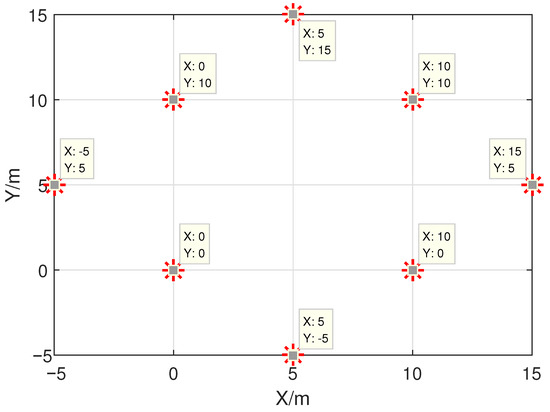
Figure 1.
Coordinate diagram of base stations.
Example 1.
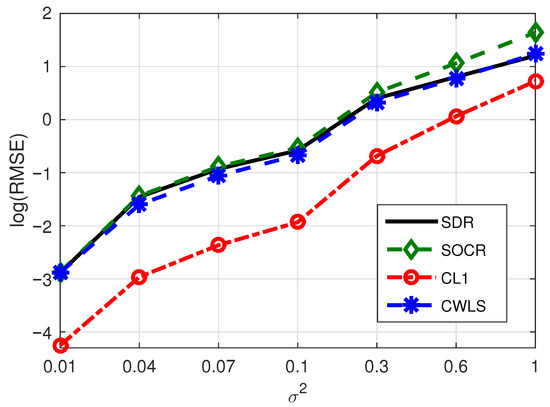
In this example, we randomly select six BSs from eight BSs and fix the number of NLOS paths as one to test the localization accuracy of different methods. Corresponding positioning performance of four algorithms are shown in Figure 2, from which we see that the CL1 method is significantly superior to SDR, CWLS and SOCR methods, indicating that L1-norm can also be applied to the localization problem in a simple and direct way. Since L2 norm is mainly applicable to Gaussian white noise environment and L1 norm is applicable to sparse environment, it is normal that SDR, SOCR and CWLS methods, which based on L2 norm, have poor performance.

Figure 2.
RMSE comparison of four methods under the conditions of six BSs and one NLOS.
Example 2.
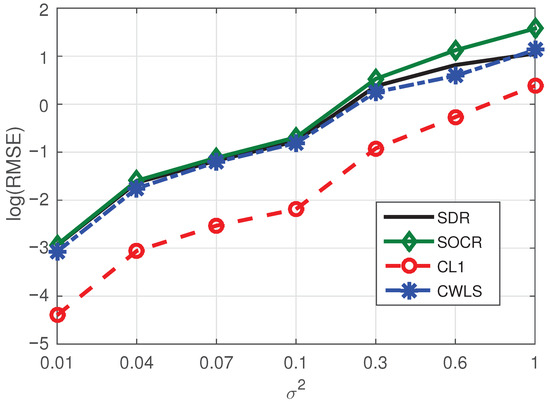
In this example, we set the number of NLOS paths and BSs as one and seven, respectively. Corresponding simulation results are shown in Figure 3. Obviously, CL1 method still performs better than the other three algorithms. Since sparse method has great advantages in sparse environment, it is normal that our method based on sparse technology has good advantages.

Figure 3.
RMSE comparison of four methods under the conditions of seven BSs and one NLOS.
Example 3.
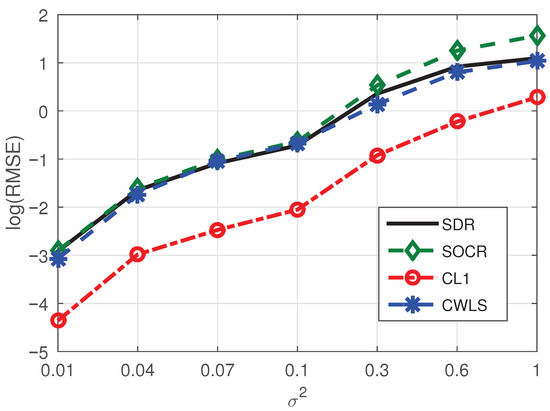
To test the positioning performance of the proposed method when BSs contain errors, we add Gaussian white noise with mean 0 and variance 0.02 to the BSs based on Example 2. Corresponding localization results are shoun in Figure 4. Obviously, both Figure 3 and Figure 4 are basically consistent in terms of curve values and trends, indicating that BSs with noise have little influence on our method.

Figure 4.
RMSE comparison of four methods under the conditions of seven BSs with noises and one NLOS.
Example 4.
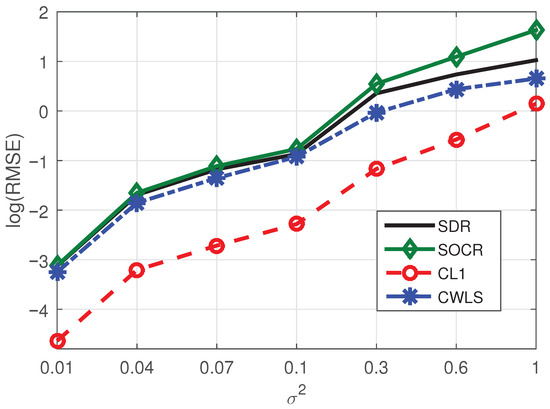
In this test, we set the number of BSs as eight and fix the number of NLOS paths as one to further test the performance of CL1 method. Corresponding simulation results are shown in Figure 5 and corresponding conclusions are consistent with Example 1, Example 2 and Example 3.

Figure 5.
RMSE comparison of four methods under the conditions of eight BSs and one NLOS.
Example 5.
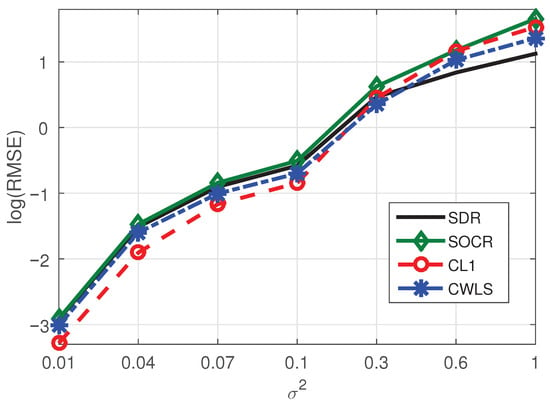
To further verify the localization performance of the CL1 algorithm, we set the number of NLOS paths as two and other conditions are consistent with Example 4. The simulation results are shown in Figure 6, from which we see that the performance of CL1 method is superior to SDR, CWLS and SOCR methods in low-noise scenario, and the performance of four algorithms is almost the same in the high-noise condiiton.

Figure 6.
RMSE comparison of four methods under the conditions of eight BSs and two NLOS.
Example 6.

To test the calculation speed of the four algorithms above, we characterize it by calculating the time consumed by each algorithm in the process of running each program 400 times. Based on the conditions of example 3, we set and then the result of each computation time will be shown in the Table 1. We see that the algorithm with the shortest time is CL1 method, followed CWLS and SOCR methods, and finally SDR method. There will be some differences between above four algorithms running on different computers, different software, and different environments, but the ratio of computational time between algorithms will not change. Additionally, our algorithm needs to iterate 70 times to reach the convergence solution on average.

Table 1.
Average computation time (in seconds) of four algorithms.
Consequently, considering the experimental test results shown in Figure 2, Figure 3, Figure 4, Figure 5 and Figure 6 and Table 1, we can draw the following conclusions:
- (1)
- The proposed algorithm has great advantages in positioning accuracy and has some advantages in computational speed.
- (2)
- Even if the base station contains noise, its influence on the positioning performance of the proposed algorithm is limited.
- (3)
- When the number of BSs increases while the number of NLOS paths remains constant, the positioning performance of the proposed method will be improved due to the increase of sparsity. On the contrary, the BSs remains unchanged, and when the number of NLOS paths increases, the localization performance of our method will be reduced due to the decrease of sparsity.
Although our algorithm is currently only applicable to the mixed sparse LOS/NLOS environments, it is still of reference value to the academic community. In the future, we will devote ourselves to the study of high-precision positioning algorithms in non-sparse environment or NLOS condition.
4. Conclusions
In this paper, we propose a constrained L1-norm minimization method, simple and efficient, to improve the positioning accuracy and speed up calculation under mixed sparse LOS/NLOS conditions. Based on the conditions that the magnitudes of NLOS errors are much larger than the Gaussian noises and the number of LOS paths is larger than that of NLOS paths, the residuals can form a sparse vector which fully guarantees that our algorithm is innovative and feasible in principle. Meanwhile, experimental simulation results also confirm that the proposed algorithm not only has the advantage of fast computation speed, but also can achieve a high positioning accuracy with no need to identify NLOS status and estimate NLOS errors.
Author Contributions
C.H. conceived and designed the experiments; C.H. and Y.Y. analyzed the data; Y.Y. and B.T. reviewed the analyzed data and contributed to the writing. All authors have read and agreed to the published version of the manuscript.
Funding
This work was supported by the National key Research Program of China (2016YFB0501900), National Natural Science Foundation of China (41674022) and Independent deployment project of State Key Laboratory in Innovation Academy for Precision Measurement Science and Technology (APM), Chinese Academy of Sciences (E025011001).
Institutional Review Board Statement
Not applicable.
Informed Consent Statement
Not applicable.
Data Availability Statement
Not applicable.
Conflicts of Interest
The authors declare no conflict of interest.
References
- Xu, C.; He, J.; Zhang, X. Toward Near-Ground Localization: Modeling and Applications for TOA Ranging Error. IEEE Trans. Antennas Propag. 2018, 66, 1052. [Google Scholar] [CrossRef]
- Cheung, K.W.; So, H.C.; Ma, W.K.; Chan, Y.T. Least Squares Algorithms for Time-of-Arrival-Based Mobile Location. IEEE Trans. Signal Process. 2004, 52, 1121–1128. [Google Scholar] [CrossRef]
- Go, S.; Chong, J. An efficient TOA-based localization scheme based on BS selection in wireless sensor networks. IEICE Trans. Commun. 2014, 97, 2560–2569. [Google Scholar] [CrossRef]
- Falsi, C.; Dardari, D.; Mucchi, L.; Win, M.Z. Time of arrival estimation for uwb localizers in realistic environments. Eurasip J. Adv. Signal Process. 2006, 2006, 1–13. [Google Scholar] [CrossRef]
- Shi, Q.; Cui, X.W.; Zhao, S.H. Sequential TOA-Based Moving Target Localization in Multi-Agent Networks. IEEE Commun. Lett. 2020, 24, 1719–1723. [Google Scholar] [CrossRef]
- Wu, S.X.; Zhang, S.J.; Xu, K. Neural Network Localization With TOA Measurements Based on Error Learning and Matching. IEEE Access 2019, 7, 19089–19099. [Google Scholar] [CrossRef]
- Wang, W.; Wang, G.; Zhang, J.; Li, Y.M. Robust weighted least squares method for TOA-Based localization under mixed LOS/NLOS conditions. IEEE Wireless Commun. Lett. 2017, 21, 2226–2229. [Google Scholar] [CrossRef]
- Guvenc, L.; Chong, C. A Survey on TOA Based Wireless Localization and NLOS Mitigation Techniques. IEEE Commun. Surv. Tutor. 2009, 11, 107–124. [Google Scholar] [CrossRef]
- Wang, G.; Chen, H.; Li, Y.M.; Ansari, N. NLOS error mitigation for TOA-based localization via convex relaxation. IEEE Trans. Wirel. Commun. 2014, 13, 4119–4131. [Google Scholar] [CrossRef]
- Momtaz, A.A.; Behnia, F.; Amiri, R.; Marvasti, F. NLOS identification in range-based source localization: Statistical Approach. IEEE Sens. J. 2018, 18, 3745–3751. [Google Scholar] [CrossRef]
- Cheng, L.; Huang, S.H.; Xue, M.K. A Robust Localization Algorithm Based on NLOS Identification and Classification Filtering for Wireless Sensor Network. Sensors 2020, 20, 6634. [Google Scholar] [CrossRef]
- Liu, D.W.; Lee, M.C.; Pun, C.M. Analysis of wireless localization in nonline-of-sight conditions. IEEE Trans. Veh. Technol. 2013, 62, 1484–1492. [Google Scholar] [CrossRef]
- Chan, Y.T.; Tsui, W.Y.; So, H.C.; Ching, P.C. Time-of-arrival based localization under NLOS conditions. IEEE Trans. Veh. Technol. 2006, 55, 17–24. [Google Scholar] [CrossRef]
- Venkatesh, S.; Buehrer, R.M. NLOS mitigation using linear programming in ultrawideband location-aware networks. IEEE Trans. Veh. Technol. 2007, 56, 3182–3198. [Google Scholar] [CrossRef]
- Zhang, S.J.; Gao, S.C.; Wang, G.; Li, Y.M. Robust NLOS error mitigation method for TOA-based localization via second-order cone relaxation. IEEE Commun. Lett. 2015, 19, 2210–2213. [Google Scholar] [CrossRef]
- Chen, H.T.; Wang, W.; Ansari, N. Improved robust TOA-based localization NLOS balancing parameter estimation. IEEE Trans. Veh. Technol. 2019, 6, 6177–6181. [Google Scholar] [CrossRef]
- Marano, S.; Gifford, W.M.; Wymeersch, H.; Win, M.Z. NLOS identification and mitigation for localization based on UWB experimental data. IEEE J. Sel. Areas Commun. 2010, 28, 1026–1035. [Google Scholar] [CrossRef]
- Chen, H.Y.; Wang, G.; Wang, Z.Z.; Poor, H.V. Non-Line-of-Sight node localization based on semi-definite programming in wireless sensor networks. IEEE Trans. Wirel. Commun. 2012, 11, 108–116. [Google Scholar] [CrossRef]
- Tomic, S.; Beko, M. A bisection-based approach for exact target localization in NLOS environments. Signal Process. 2018, 143, 328–335. [Google Scholar] [CrossRef]
- Chen, S.; Zhang, J.; Xu, C. Robust Distributed Cooperative Localization with NLOS Mitigation based on Multiplicative Convex Model. IEEE Access 2019, 7, 112907–112920. [Google Scholar] [CrossRef]
- Tomic, S.; Beko, M.; Dinis, R. A Robust Bisection-Based Estimator for TOA-Based Target Localization in NLOS Environments. IEEE Commun. Lett. 2017, 21, 2488–2491. [Google Scholar] [CrossRef]
- Tomic, S.; Beko, M. A Robust NLOS Bias Mitigation Technique for RSS-TOA-Based Target Localization. IEEE Signal Process. Lett. 2019, 26, 64–68. [Google Scholar] [CrossRef]
- Cui, W.; Li, B.; Zhang, L. Robust Mobile Location Estimation in NLOS Environment Using GMM, IMM, and EKF. IEEE Syst. J. 2018, 13, 3490–3500. [Google Scholar] [CrossRef]
- Park, C.; Chang, J. WLS Localization Using Skipped Filter, Hampel Filter, Bootstrapping and Gaussian Mixture EM in LOS/NLOS Conditions. IEEE Access 2019, 7, 35919–35928. [Google Scholar] [CrossRef]
- Wang, Y.; Jing, Y.; Jia, Z. An indoor mobile localization strategy for robot in NLOS environment. Int. J. Distrib. Sens. Netw. 2013, 9, 758749. [Google Scholar] [CrossRef]
- Ding, C.; Qi, H.D. Convex Euclidean distance embedding for collaborative position localization with NLOS mitigation. Comput. Optim. Appl. 2017, 66, 187–218. [Google Scholar] [CrossRef]
- Liang, J.; Chen, Y.; So, H.C.; Jing, Y. Circular/hyperbolic/elliptic localization via Euclidean norm elimination. Signal Process. 2018, 148, 102–113. [Google Scholar] [CrossRef]
- Chen, P.C. A non-line-of-sight error mitigation algorithm in location estimation. In Proceedings of the 1999 IEEE Wireless Communications and Networking Conference, New Orleans, LA, USA, 21–24 September 1999; pp. 316–320. [Google Scholar]
- Yi, L.L.; Razul, S.G.; Lin, Z.P.; See, C.M. Target Tracking in Mixed LOS/NLOS Environments Based on Individual Measurement Estimation and LOS Detection. IEEE Trans. Wirel. Commun. 2014, 13, 99–111. [Google Scholar] [CrossRef]
- Mucchi, L.; Marcocci, P. A new parameter for UWB indoor channel profile identification. IEEE Trans. Wirel. Commun. 2009, 8, 1597–1602. [Google Scholar] [CrossRef]
- Geng, C.H.; Yuan, X.; Huang, H. Exploiting Channel Correlations for NLOS ToA Localization with Multivariate Gaussian Mixture Models. IEEE Wirel. Commun. Lett. 2020, 9, 70–73. [Google Scholar] [CrossRef]
- He, C.W.; Yuan, Y.B.; Tan, B.F. Alternating Direction Method of Multipliers for TOA-based Positioning under Mixed Sparse LOS/NLOS Environments. IEEE Access. 2021. accept. [Google Scholar]
- Donoho, D.L. Compressed Sensing. IEEE Trans. Inf. Theory 2006, 52, 1289–1306. [Google Scholar] [CrossRef]
- Elad, M. Sparse and Redundant Representations: From Theory to Applications in Signal and Image Processing; Springer Publishing Company: New York, NY, USA, 2010. [Google Scholar]
- Zhu, Y.; Deng, B.; Jiang, A.; Liu, X.; Tang, Y.; Yao, X. ADMM-based TDOA Estimation. IEEE Commun. Lett. 2018, 22, 1406–1409. [Google Scholar] [CrossRef]
- Boyd, S.; Parikh, N.; Chu, E.; Peleato, B.; Eckstein, J. Distributed optimization and statistical learning via the alternating direction methodof multipliers. Found. Trends Mach. Learn. 2011, 3, 1–122. [Google Scholar] [CrossRef]
- He, B.S.; Yang, H.; Wang, S.L. Alternating direction method with self-adaptive penalty parameters for monotone variational inequalities. J. Optim. Theory Appl. 2000, 106, 337–356. [Google Scholar] [CrossRef]
- Wen, F.; Liu, P.; Liu, Y.; Qiu, R.C.; Yu, W. Robust Sparse Recovery in Impulsive Noise via ℓp − ℓ1 Optimization. IEEE Trans. Signal Process. 2017, 65, 105–118. [Google Scholar] [CrossRef]
Publisher’s Note: MDPI stays neutral with regard to jurisdictional claims in published maps and institutional affiliations. |
© 2021 by the authors. Licensee MDPI, Basel, Switzerland. This article is an open access article distributed under the terms and conditions of the Creative Commons Attribution (CC BY) license (http://creativecommons.org/licenses/by/4.0/).